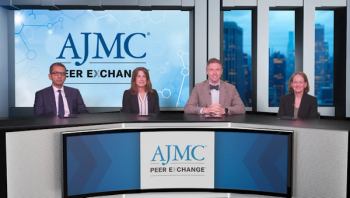
Phase 3 Trial Results Highlight Cemiplimab’s Potential in NSCLC
Data from the EMPOWER-Lung 1 trial of cemiplimab (Libtayo) monotherapy vs chemotherapy show why the fully-human monoclonal antibody could become a new treatment option for non–small cell lung cancer (NSCLC).
Data from the EMPOWER-Lung 1 trial of cemiplimab (Libtayo) monotherapy vs platinum-based doublet chemotherapy show why the fully-human monoclonal antibody could become a new treatment option for first-line locally advanced or metastatic non–small cell
“In new analyses presented at ESMO, Libtayo reduced the risk of death by 43% in patients whose cancer had confirmed PD-L1 expression of 50% or greater. This is notable given that nearly three-quarters of patients crossed over from chemotherapy following disease progression and 12% of patients had pretreated and stable brain metastases,” Ahmet Sezer, MD, associate professor in the Department of Medical Oncology at Başkent University in Adana, Turkey, and a trial investigator,
In the open-label, multicenter, phase 3 trial, the 710 study participants were almost equally randomized into 2 groups: cemiplimab (n = 356) and investigator’s choice of chemotherapy (n = 354). Both groups had the same median follow-up of 13 months and range of follow-up, at <1 to 32 months. Overall survival (OS) and progression-free survival (PFS) were the primary end points, with overall response rate, duration of response, and quality of life being the secondary end points.
The overall results demonstrate cemiplimab’s superiority on several fronts compared with chemotherapy:
- Risk of death decreased 32% (HR, 0.68; 95% CI, 0.53-0.87; P = .0022).
- Median OS of 22.1 months (95% CI, 17.7 months-not evaluable) vs 14.3 months (95% CI, 11.7-19.2)
- Risk of disease progression dropped 41% (HR, 0.59; 95% CI, 0.49-0.72; P < .0001), equating to a PFS of 6.2 months (95% CI, 4.5-8.3) vs 5.6 months (95% CI, 4.5-6.1).
- Objective response rate of 37% (3% had a complete response [CR], 33% had a partial response [PR]; 95% CI, 32%-42%) vs 21% (1% had a CR, 20% had a PR; 95% CI, 17%-25%)
Cemiplimab’s benefit carried over into the 563 patients (cemiplimab group, n = 283; chemotherapy group, n = 280) with confirmed PD-L1 expression of at least 50%. Both groups again had the same 11-month median follow-up, with almost equal ranges: <1 to 32 months and <1 to 30 months, respectively. Results in this group demonstrated the following:
- Risk of death decreased 43% (HR, 0.57; 95% CI, 0.42-0.77; P = .0002).
- Median OS not reached (95% CI, 17.9 months-not evaluable) vs 14.2 months (95% CI, 11.2-17.5).
- Risk of disease progression dropped 46% (HR, 0.54; 95% CI, 0.43-0.68; P <. 0001), equating to a PFS of 8.2 months (95% CI, 6.1-8.8) vs 5.7 months (95% CI, 4.5-6.2).
- Objective response rate of 39% (2% had a CR, 37% had a PR; 95% CI, 34%-45%) vs 20% (1% had a CR, 19% had a PR; 95% CI, 16%-26%)
The PD-L1 IHC 22C3 pharmDx was used to confirm PD-L1 expression.
Treatment in the trial consisted of 350-mg intravenous (IV) cemiplimab every 3 weeks, for a maximum of 108 weeks, or investigator’s choice of standard-of-care chemotherapy for 4 to 6 cycles (with or without histology-relevant maintenance pemetrexed chemotherapy).
Importantly, objective response rate to cemiplimab was highest in tumors with at least 90% PD-L1 expression: 46% (range, 36%-56%). These tumors shrunk more than 40% after an average 6 months of treatment. Similar findings were not seen with chemotherapy.
The cemiplimab-treated patients also experienced 32% fewer grade 3 adverse events (AEs) overall: 37% vs 49% of patients receiving chemotherapy. The most common immune-mediated AEs, which occurred in 17% of patients receiving cemiplimab, were hypothyroidism (6%), hyperthyroidism (4%), pneumonitis (2%), hepatitis (2%), skin adverse reaction (2%), and arthritis, increased blood thyroid stimulating hormone, thyroiditis, colitis, nephritis, and peripheral neuropathy (each 1%).
Crossover was allowed from the chemotherapy to the cemiplimab arm, and occurred with 73.9%, and those receiving cemiplimab could combine it with 4 to 6 cycles of chemotherapy.
Cemiplimab already holds indications in the United States, European Union, and other countries for metastatic cutaneous squamous cell carcinoma (CSCC) or locally advanced CSCC in adults for whom curative surgery or radiation are not treatment options.
Reference
Sezer A, Kilickap S, Gümüş M, et al. EMPOWER-Lung 1: phase III first-line (1L) cemiplimab monotherapy vs platinum-doublet chemotherapy (chemo) in advanced non-small cell lung cancer (NSCLC) with programmed cell death-ligand 1 (PD-L1) ≥50%. Presented at: European Society for Medical Oncology Virtual Congress 2020; September 19-21, 2020. Abstract LBA-52.
Newsletter
Stay ahead of policy, cost, and value—subscribe to AJMC for expert insights at the intersection of clinical care and health economics.








































